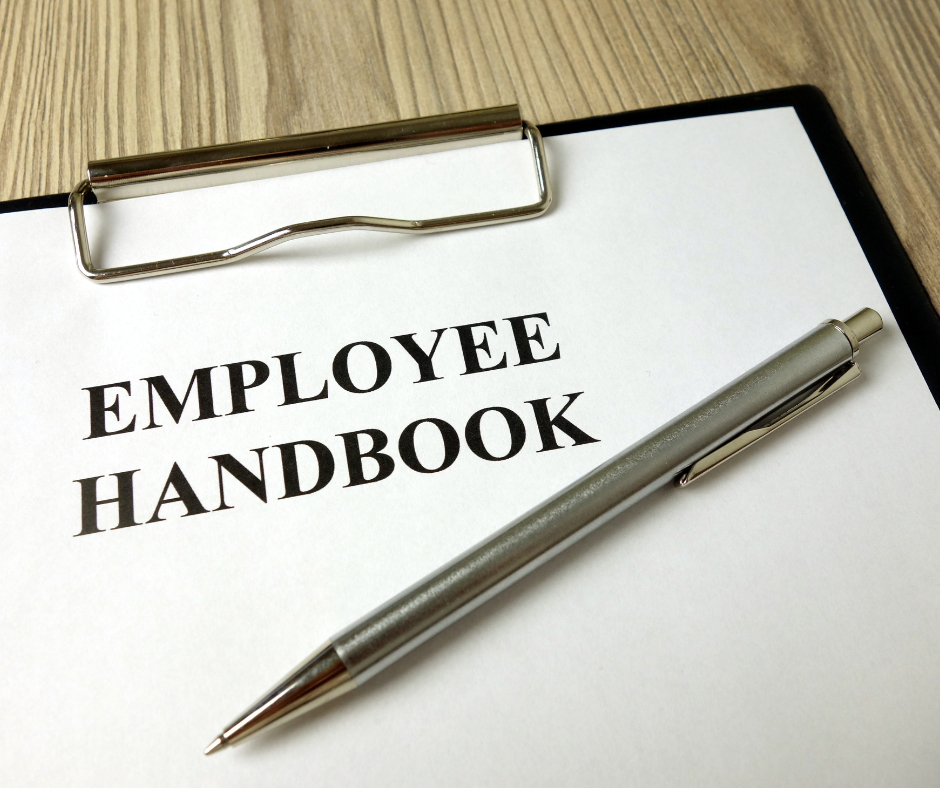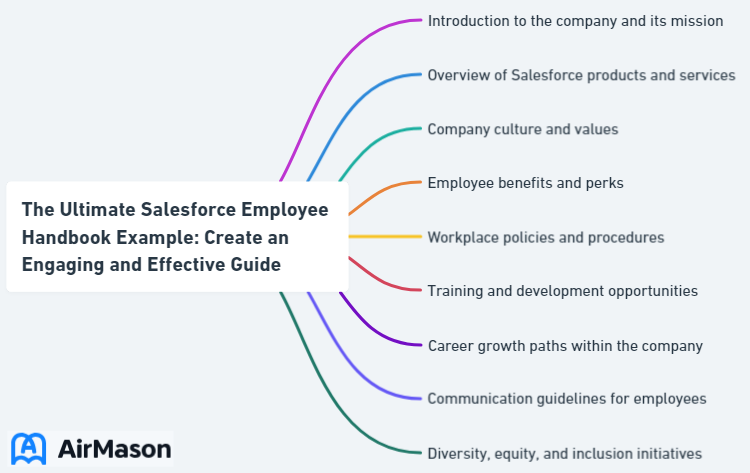
Imagine having an employee handbook that not only communicates your company’s policies and procedures but also embodies its core values and culture, creating an engaging experience for your employees. Salesforce, a global leader in customer relationship management (CRM), has achieved this with their comprehensive “salesforce employee handbook example”. By taking inspiration from Salesforce’s example, you can create a handbook that serves as a powerful tool for employee engagement, productivity, and retention. Curious about how to develop such a resource? Keep reading to learn the key components of the salesforce employee handbook example and discover the steps you can follow to create a similar guide for your own organization.
Key Takeaways
- Salesforce’s Employee Handbook outlines core values, culture, customer relationships and code of conduct.
- Creating a handbook involves considering company values, engaging design & format plus regular updates for compliance.
- Tools and resources exist to create an effective employee handbook that reflects the company’s culture while providing employees with relevant information & resources.
Understanding Salesforce’s Employee Handbook
Salesforce’s employee handbook is a critical part of the company’s comprehensive guide that emphasizes core values, company culture, and customer relationships, providing employees with an essential resource.
The handbook’s main components include an introduction to the organization and its principles, a code of conduct, and a policy on equal employment and nondiscrimination. Through this approach, Salesforce sets a strong foundation for its employees, helping them understand the company’s values and expectations.

Core Values and Company Culture
Salesforce’s core values are:
- Trust
- Customer Success
- Innovation
- Equality
- Sustainability
The handbook effectively communicates these values and the company culture, guiding employees’ daily behaviors, actions, and decisions. Emphasizing teamwork, collaboration, and a supportive work environment, Salesforce encourages employees to form relationships and collaborate on shared objectives.
This focus on core values and culture not only creates a strong sense of purpose but also fosters an inclusive workplace that encourages innovation, continuous learning, and personal growth.
Fortune 500 Companies Employee Handbook
Welcome to the comprehensive guide that is the Fortune 500 Companies Employee Handbook. In this invaluable resource, you will find detailed insights into the policies, practices, and expectations that shape the employee experience within the esteemed realm of Fortune 500 organizations. This handbook serves as a roadmap for navigating the dynamic landscapes of these influential companies, offering essential information on everything from workplace conduct and professional development to benefits and corporate culture. As you embark on your journey within a Fortune 500 company, refer to this handbook for guidance, ensuring a fulfilling and successful career path within these industry leaders.
Customer Relationships and CRM
Besides its core values and culture, Salesforce’s employee handbook also strongly emphasizes customer relationships and CRM principles. The handbook guides employees on how to use CRM tools like Salesforce’s own software, which offers various features and capabilities for managing customer relationships.
The handbook equips employees with:
- Comprehensive training on CRM principles and best practices
- Resources to make informed decisions for each customer
- Improved sales, productivity, and overall business performance.
Key Sections in a Salesforce Employee Handbook
A well-structured employee handbook is essential in providing employees with guidance on various aspects of their employment. The key sections in a Salesforce employee handbook include health and safety policies, employee benefits and perks, and performance management and goal setting. These sections ensure that employees have access to pertinent information and resources, enabling them to perform their roles effectively and in alignment with the company’s values.
Health and Safety Policies

Salesforce’s employee handbook outlines health and safety policies that emphasize:
- General security and safety awareness
- Training
- Reporting
- Proactive risk identification and response
These policies strive to guarantee a secure and safe workplace environment for employees. By incorporating health and safety policies in the handbook, Salesforce ensures a secure work environment and adheres to applicable regulations.
This approach not only protects employees from accidents and injuries but also fosters trust in the organization’s commitment to employee well-being.
Employee Benefits and Perks

Salesforce communicates their employee benefits and perks in their handbook through various sections such as Insurance, Health & Wellness, Financial & Retirement, Family & Parenting, Vacation & Time Off, and Perks & Discounts. The precise details of these benefits and perks may differ, but they typically include offerings such as health insurance, wellness reimbursement, retirement plans, parental leave, vacation time, and employee discounts.
Salesforce details these benefits in the handbook, offering comprehensive information on eligibility and usage. This ensures employees clearly understand and can access the available perks and benefits.
Performance Management and Goal Setting
Salesforce’s employee handbook outlines performance management and goal setting principles that help employees understand expectations and achieve alignment with company objectives. By using the S.M.A.R.T. method (Specific, Measurable, Attainable, Relevant, and Time-based) and promoting collaborative goal setting between managers and employees, Salesforce guides its employees in refining goals and refocusing efforts as priorities shift.
This approach encourages employees to continually improve and strive for excellence, with performance management and goal setting guided by Salesforce’s core values:
- Trust
- Customer success
- Innovation
- Equality
- Sustainability
How to Create Your Own Salesforce-Inspired Employee Handbook

Taking inspiration from Salesforce’s employee handbook, you can create a comprehensive guide for your own organization that incorporates your company’s core values, culture, and essential policies. Creating a Salesforce-inspired employee handbook involves considering three key aspects: showcasing your company’s core values, incorporating engaging design and format, and maintaining regular updates and compliance.
Reflecting Your Company’s Core Values
To create an employee handbook that reflects your company’s core values, start by outlining your values and culture and integrating them into the guiding principles and policies in the handbook. This approach will set the tone for employee behavior and expectations, helping employees understand the values that drive your organization’s decisions and actions.
Incorporating your company’s core values and culture into the handbook paves the way for a more cohesive and values-driven work environment.
Engaging Design and Format
An engaging design and format are essential for creating a visually appealing and user-friendly employee handbook. Salesforce’s employee handbook, for example, incorporates style, colors, and spacing to ensure readability and engagement.
A conversational writing style and quality visuals can make the handbook more engaging for your employees. Also, ensure your handbook is easy to navigate by incorporating headings, bullet points, and images, as seen in Salesforce’s handbook.
Regular Updates and Compliance
Regularly updating your employee handbook is crucial to maintain relevance and compliance with changing regulations and policies. It is recommended to assess your handbook for compliance at least annually. To ensure your handbook adheres to relevant laws and regulations, consider incorporating centralized storage, workflow automation, access control, audit-ready reporting, and policy management software such as PowerDMS, Trainual, and PolicyTech.
Regular updates and compliance checks on your handbook safeguard your organization and provide your employees with the most current information and resources.
Tools and Resources for Creating an Engaging Employee Handbook

Creating an engaging employee handbook is a critical part of fostering a strong company culture and guiding employees to success. Various tools and resources are available to help you create a visually appealing and user-friendly handbook, including handbook builders, compliance resources, and employee feedback channels.
Handbook Builders
Handbook builders are platforms that offer templates and customization options to create visually appealing and user-friendly handbooks. Platforms such as Canva, AirMason, and Workest by Zenefits provide templates that are fully customizable, allowing you to tailor them to your specific needs and requirements.
Using a handbook builder enables you to craft an engaging and accessible employee handbook that mirrors your company’s values and culture.
Compliance Resources
To ensure your employee handbook adheres to relevant laws and regulations, consider incorporating compliance resources such as:
- Centralized storage
- Workflow automation
- Access control
- Audit-ready reporting
- Policy management software like PowerDMS, Trainual, or PolicyTech
These resources can help you track policy and regulation changes, maintain compliance, and support your organization in safeguarding from potential legal issues.
Employee Feedback Channels
Using employee feedback channels is essential for continuous improvement and updates based on employee needs and suggestions. Companies like Salesforce implement various feedback channels, including:
- Post-chat
- SMS
- Third-party websites
- Surveys
Incorporating employee feedback into the creation and revision of your employee handbook ensures its relevance, clarity, and addresses the needs and concerns of your workforce.
Case Studies: Companies Inspired by Salesforce’s Employee Handbook

To illustrate the benefits of a well-crafted employee handbook that reflects company values and culture, let’s examine the experiences of two companies that have successfully implemented Salesforce-inspired handbooks: Company A and Company B.
Company A
Company A, a marketing communications agency, incorporated elements from Salesforce’s handbook, including the Book of Business components and standard products and features for managing customer relationships. Implementing a Salesforce-inspired handbook enabled Company A to enhance employee engagement and comprehension of its values.
This led to a more cohesive company culture, with employees and partners aligning their actions and behaviors with the organization’s values and working together towards shared objectives.
Company B
Company B, a software development company, used a Salesforce-inspired handbook to streamline its onboarding and training processes, leading to increased employee satisfaction and retention. The comprehensive handbook provided new employees with pertinent information regarding the company, its culture, and policies, as well as training materials and resources for learning Salesforce and its functionalities.
Improving the efficiency and effectiveness of its onboarding and training processes, Company B ensured that new employees were adequately prepared to perform their roles successfully.
Summary
In conclusion, a well-crafted employee handbook inspired by Salesforce’s example can serve as a powerful tool for employee engagement, productivity, and retention. By incorporating your company’s core values, using engaging design and format, and ensuring regular updates and compliance, you can create a comprehensive guide that reflects your organization’s values and culture.
As demonstrated by the case studies of Company A and Company B, implementing a Salesforce-inspired employee handbook can lead to improved employee engagement, understanding of company values, streamlined onboarding and training processes, and increased employee satisfaction and retention. By following these best practices and utilizing the available tools and resources, you can create an engaging and effective employee handbook tailored to your organization’s unique needs.
Paramount Global Employee Handbook Example
In the Paramount Global employee handbook example, employees gain valuable insights into the company’s policies, values, and expectations. This comprehensive guide serves as a resource for navigating the workplace, providing clarity on everything from code of conduct to employee benefits. Paramount Global’s commitment to fostering a positive work environment is evident in the detailed guidelines outlined in the handbook. By familiarizing themselves with this document, employees can ensure a harmonious and productive experience within the Paramount Global community.
Frequently Asked Questions
How does Salesforce treat their employees?
Salesforce is committed to establishing a great workplace culture of trust and respect, with 70% of their employees believing it is a great place to work compared to 57% of U.S.-based companies. Employees are welcome when they join and able to take time off when they think it necessary.
What benefits do Salesforce employees get?
Salesforce offers comprehensive benefits to its employees, including competitive compensation, health savings accounts, life insurance coverage, parental leave, retirement plans, and stock options, demonstrating their commitment to supporting them in various aspects of their life.
Is Salesforce a good company to work for?
Salesforce has an overall rating of 4.0 out of 5, based on over 18,173 reviews, and 77% of employees would recommend working there to a friend. 64% of employees also have a positive outlook for the business. Overall, it appears to be a good company to work for.
What are the key components of Salesforce’s employee handbook?
The key components of Salesforce’s employee handbook include core values, company culture, customer relationships, health and safety policies, employee benefits and perks, and performance management and goal setting.
How can I create a visually appealing and user-friendly employee handbook?
Create a visually appealing and user-friendly employee handbook by utilizing engaging design and format, incorporating headings, bullet points, images, conversational writing style, and quality visuals.
Important Disclaimer:
The article presented here does not serve as a representation of the company’s actual employee handbook mentioned in this article.
Our discussions and insights regarding employee handbook are based on assumptions about what may be considered significant in this companies’ policies. These assumptions are drawn from available information and industry knowledge. Readers are advised that the content provided is for informational purposes only and should not be construed as an exact reflection of any company’s official policies or procedures. For precise and accurate details regarding a company’s employee handbook, individuals should refer directly to the company’s official documentation or consult with appropriate representatives.
Please be aware that the content on this page has been generated by using artificial intelligence language models and may contain errors, inconsistencies, or outdated information. It is provided as-is without any warranties or guarantees of accuracy. We strongly recommend using this content as a starting point for further research. We disclaim any liability for damages or losses resulting from the use or reliance on this content.